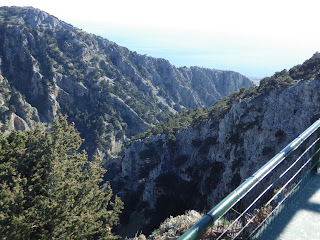I visited the graves of 5 young Canadians killed in the Battle of Crete in 1941 today. The bottom of this marker says "missing but never forgotten". He was 20
They are buried in the Commonwealth War Cemetery located at the end of Souda Bay.

They were all airmen, mostly pilots, serving with the British Air Force.
In this case these two men, one Canadian and the other British, crewed together, died together and thus are buried together. He was 21 and from Trail BC. When I lived in the interior of BC before moving to NB, I lived just up the hill from his home.
This is another mixed crew, British and New Zealand airmen similarly, having served together, buried together.
The Souda Bay Cemetery is the final resting place for the remains of 1527 soldiers, mostly from Britain, New Zealand and Australia.

I walked every row of this cemetery twice searching for the monuments to our five Canadians here. I found three. There is no guide book in this cemetery, as often found in others, to aid in finding a specific grave.
What gave me pause as I began my search, is that well over half of the makers indicate this is a "soldier known unto God"
Note the inscription on the top of this stone, "Believed to be..."

Every time I visit one of these cemeteries the incredible waste of life confronts me.
The Battle for Crete is one we Canadians know little about. It came towards the end of that long struggle at the beginning of WW2 when the allies were having a hard time stopping the Germans anywhere.
The Allies lost this battle. 12,000 were captured. 18,000 were evacuated by the British Navy and about 2000 died, many of whom were never found.
This is the gorge the Allies fought their retreat through. It is steep, harsh, rugged. It is unimaginable to me what it might have been like.

This map depicts the naval battle for Crete. Each white marker is a British ship sunk. The British desperately wanted to keep the island in order to limit German ability to exert power, but after heavy loss of ships and damage to many more, England simply could not afford the cost to keep Crete. The main war effort to stop the Germans then moved to North Africa and the Battle of El Alamain.
Last Saturday I visited the German Cemetery on the western part of the island at Maleme, one of the main paratroop landing fields. Many young Germans were slaughtered in the first phase of the land battle.

Over 4000 Germans soldiers are buried in this site on a ridge overlooking the main drop zones and the sea. This was the first time in history a large paratrooper attack was ever attempted.
Hitler was so horrified by the heavy losses that he ordered the paratroop divisions disbanded and never to be used again.
Here is a marker to German unknown soldiers. In this cemetery, each flat stone has two names on it.
 This is a Cretan wedding dress made from the silk parachute lines from German parachutes retrieved after the battle. I came across this dress in the Naval Museum in Chania.
This is a Cretan wedding dress made from the silk parachute lines from German parachutes retrieved after the battle. I came across this dress in the Naval Museum in Chania.The Cretans have various ways to acknowledging their victory over oppression. This is one such gesture we may find hard to understand, but neither are we a people oppressed for centuries by one power or another.
Another example are the head coverings worn by Cretan mountain men in the villages. Each tassel symbolizes a man this man killed. Most would be German.
The British, Canadian and Americans took notice of this parachute attack and concluded this, although very risky and extremely costly in lives, could have enormous benefits. Thus the paratroop regiments and divisions were born that would be so successful later in the war.

On the same day I went to Maleme, I visited this lonely mountain top memorial overlooking the sea and the German drop zones. It is dedicated to the youth of Crete who also joined in the battle to protect their homes from the Germans.
Note the ancient Greek shield on the right of the top monument

On another hill I came across this memorial site that appears to honour soldiers and freedom fighters who fought for their island dating back into the 1800's.
This memorial stands beside the harbour in Chania and is dedicated to the 267 Jewish men, women and children who died when a British submarine torpedoed the ship they were on. It sank just outside the harbour. No one survived. They were on their way to northern Europe to be killed in the extermination camps.
It all serves to remind us that when someone offers a war...
... everyone dies.











No comments:
Post a Comment
Thank you for reading my blog. I look forward to reading your comments.